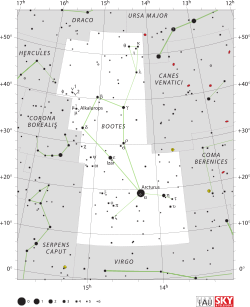Tau Herculids
| Tau Herculids | |
|---|---|
| Parent body | 73P/Schwassmann–Wachmann |
| Radiant | |
| Constellation | Boötes[1] |
| Right ascension | 13h 56m |
| Declination | +28° |
| Properties | |
| Occurs during | May 19 – June 19 |
| Date of peak | May 31[1] |
| Velocity | 16[1] km/s |
| Zenithal hourly rate | variable (Class III) |
The Tau Herculids (TAH #0061) are a meteor shower that when discovered in 1930 appeared to originate from the star Tau Herculis. The parent comet of the Tau Herculids is periodic comet Schwassmann-Wachmann 3 with a 5.4 year orbital period. This meteor shower occurs from May 19 - June 19. The meteor shower was first observed by the Kwasan Observatory in Kyoto, Japan in May 1930. The Tau Herculids' average radiant was α=236°, δ=+41°.[2] Due to orbital perturbations of the meteor streams by Jupiter, 2022 activity will have a radiant of R.A. = 13:56 (209), Decl. = +28 (North-West of the star Arcturus in the constellation Boötes).[1] The meteors are relatively slow moving making atmospheric entry at around 16 km/s (36,000 mph).
On 31 May 1930 the comet passed about 0.062 AU (9.3 million km; 5.8 million mi) from Earth,[3] on 9 June 1930 a meteor outburst with a zenithal hourly rate of around 100 was observed,[4] and then the comet passed perihelion (closest approach to the Sun) on 14 June 1930.
On 30–31 May 2022 (31 May 4:00-5:00 UT) there was a modest meteor shower generated by fragments from the 1995 break-up of the parent comet 73P.[5][6] This required that fragments had been migrating ahead of the comet for the last 27 years.[7] The parent comet has 69 known fragments[8] and does not come to perihelion (0.97 AU from the Sun) until 25 August 2022.[9] On 30 May 2022 comet 73P/Schwassmann–Wachmann was 1.5 AU from the Sun and 1.4 AU (210 million km) from Earth.[10] The next notable appearances of the Tau Herculids are expected in 2033[6] and 2049.[4]
References[edit]
- ^ a b c d Peter Jenniskens (30 May 2022). "Anticipating a meteor outburst: Global CAMS video network detects first 2022 tau Herculids". Meteor News. Retrieved 2022-05-30.
- ^ "Meteor Showers Online". Archived from the original on 18 July 2018.
- ^ "Horizons Batch for 73P [1930] (90000728) Earth approach on 1930-05-31" (r is distance from the Sun and delta is the distance from Earth). JPL Horizons. Retrieved 2022-06-05.
- ^ a b Weigert, P.A.; Brown, P.G.; Vaubaillon, J.; Schijns, H. (2005). "The τ Herculid meteor shower and Comet 73P/Schwassmann-Wachmann 3". Monthly Notices of the Royal Astronomical Society. 361 (2): 638–644. Bibcode:2005MNRAS.361..638W. doi:10.1111/j.1365-2966.2005.09199.x.
- ^ Joe Rao (2022-05-26). "Update on a Possible Outburst of Meteors". Sky & Telescope. Retrieved 2022-05-29.
- ^ a b Robert Lunsford (2022-06-06). "Observed Meteor Outburst of tau-Herculids!". International Meteor Organization. Retrieved 2022-06-07.
- ^ Lee Mohon (2022-05-27). "New meteor shower? How many meteors will I see, really?". NASA. Retrieved 2022-05-29.
- ^ "JPL Small-Body Database Browser: 73P/Schwassmann–Wachmann (69 objects)". Retrieved 2022-05-29.
- ^ "73P/Schwassmann-Wachmann Orbit". Minor Planet Center. Retrieved 2022-05-29.
- ^ "Horizons Batch for 73P (90000733) on 2022-05-30" (r is distance from the Sun and delta is the distance from Earth). JPL Horizons. Retrieved 2022-05-29.
External links[edit]
- tau Herculids as seen by the Global Meteor Network cameras (30 May 2022 Denis Vida)
- Radio Meteor Observations (peaking around 4:00 UT 31 May)
- Tau Herculids Meteors over Kitt Peak Telescopes (Astronomy Picture of the Day accumulated over 2.5 hours very late on May 30)


 French
French Deutsch
Deutsch
